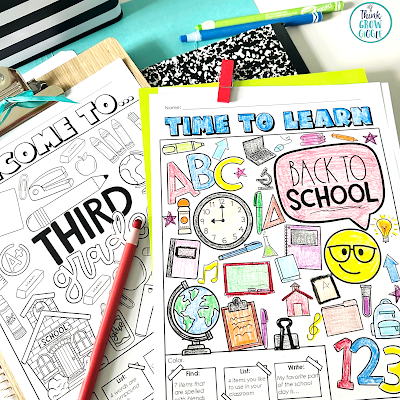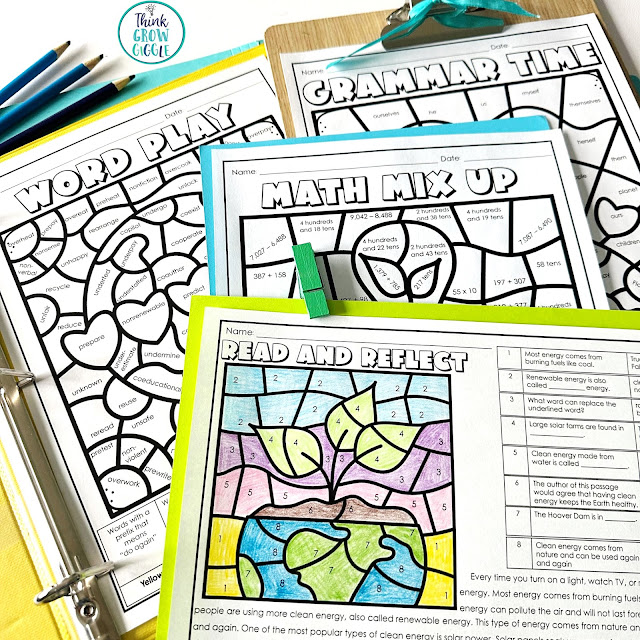The first few minutes of the school day are so important! As students trickle into the classroom, some are still sleepy and others are full of energy; so having a calm, consistent morning routine in place will kick off your day and your students' day on a positive, structured note.
A simple and predictable morning routine helps students transition smoothly from home to school, settle into the learning environment, and start the day with purpose. It provides structure, reduces unwanted behaviors, and gives me a few valuable minutes to take attendance, check in with students, and handle morning tasks.
However, more importantly, a morning routine sets a positive tone and aids in classroom management. When students know what to expect and are engaged from the start, it creates a smoother start and a more focused classroom culture throughout the day.
Our morning routine includes:
- entering the classroom and saying good morning to the teacher
- putting belongings away in the cubbies
- signing up for lunch
- handing in notes and notices
- submitting homework
- sharpening pencils
- completing morning work tasks
- morning meeting time
Whether you are a new teacher, a seasoned teacher, or changing grade levels to upper elementary, you are probably asking yourself what the best morning work for upper elementary is!
Over the years, my morning work routines and expectations have varied greatly. It has been dependent on how much time I have in the morning and whether or not we have a first-period special. Regardless of our schedule, sticking to our morning routine and completing our morning work activities is essential.
💡Teacher tip: Be sure to practice your morning routine and clearly communicate your morning work expectations to your students. We practice these routines repeatedly during the first few weeks of school.
Try these ideas to make morning work an important part of your morning routine!
Morning Work Ideas for Upper Elementary
1. Read a Book
Once students finish unpacking and settling in after arrival, picking up and reading a book is a great way to ease into the day. I have students read an independent reading book or any other book they want to select. I encourage a wide range of genres, allowing the kids to explore our classroom library. The kids do not read the books from their reading bins, as they are intended for instructional purposes. Reading a book is a simple, no-prep way to start the day that encourages the joy of reading.
2. Get Coloring
Coloring is a favorite activity among upper elementary students! Over the last few years, the kids I work with have developed a love for coloring and getting creative. That's why I love incorporating coloring pages into the classroom for morning work! We use Doodle Thinker pages and Color by Code pages during morning work. These are great ways to bring intentional coloring into the classroom that promote both relaxation and fine motor skills, while also encouraging critical thinking activities, too!
Depending on how much time you have set aside for morning work, one Doodle Thinker page or Color by Code page can be carried through a few days, making them the perfect soft start to the day that requires only copies to be made.
🖍 What are Doodle Thinker activities?
Doodle Thinker coloring pages are intentionally designed to combine coloring with ELA tasks, all focused on a specific theme. As students color the images on the page, they begin to build vocabulary and background knowledge on the topic or theme. The kids can color the pages anyway they like, offering a chance for them to get creative! After coloring, there are three activities: Find it, List it, and Write it. All three tasks are related to the topic of the coloring pages, making it easy for kids to get writing.
Try out Doodle Thinkers:
✅ Back to School Doodle Thinkers
✅ Seasonal Doodle Thinkers
✅ Holiday Doodle Thinkers
✅ Social Emotional Learning Doodle Thinkers
✅ Figurative Language Doodle Thinkers
✅ Science Doodle Thinkers (coming soon)
🖍 What are Color by Code activities?
Color by code activities are more structured way of coloring than Doodle Thinkers. Each page has a specific task or skill for students to practice. Students answer a question and color the given image based on the "code" on the page. Once all the questions are answered and the image is colored in, the students identify the mystery picture, ultimately self-checking their work.
Try out Color by Code Activities:
✅ Back to School Color by Code
✅ Seasonal and Holiday Color by Code
✅ Sports Color by Code
3. Unfinished Work
If you have your students keep an unfinished work folder, this idea is for you! In my classroom, we always have an unfinished work folder. This is a safe place for students to store any work in progress, ensuring it doesn't get lost and that it does get completed. It can be a quick math review page or a project, anything the students have not finished. Having students complete work in their unfinished work folders is a great way to incorporate a no-prep morning activity into your routine. Since not every student will have unfinished work to complete, have those without unfinished work read.
4. Word of the Day Routine
Use the morning time to build your students' vocabulary! Instead of introducing students to a word of the day, use this time to have one word for the week. Not only does it reduce teacher prep, but it also allows students to thoroughly explore the word, its syllables, parts of speech, and meaning, and provides ample time for students to practice, discuss, and write using the word of the week. This ensures mastery of each word, which is more valuable than introducing a different word to students each day.
🗣 Find out more about my tier 2 vocabulary instruction HERE!
5. Get in Grammar
Let's face it, grammar always gets cut out of our day! Get grammar into your day by adding it to your morning routine. You can do a simple sentence at the board or a quick independent activity. Either way, you will have a chance to address important grammar concepts every day of the year!
If you want to use a simple approach, write a sentence on the board each day. One or two sentences is enough. When you write the sentence, you can include simple errors like missing capitalization or end punctuation. Edit it with the class, discussing how you are fixing each sentence. Go one step further by discussing the sentence's structure, such as subject and predicate, the type of sentence it is, nouns, verbs, adjectives, and any other skills you must address. This is a simple, no-prep way to initiate grammar conversations. While this approach offers little prep, you will need to keep track of the skills you have addressed.
If you're looking for a more structured approach, grab the Getting in Grammar bundle. It includes slides and anchor charts that you can display to review the concept, as well as independent pages for students to work on each morning. While you do have to make copies of the pages, this program offers a structured approach that will help you feel confident that you have addressed all the grammar skills and concepts upper elementary students need.
Try the free noun pack below!
6. Daily Writing - Choice Boards or Would You Rather?
The more students write, the better they become! Offering students a less formal opportunity to write, outside of your writing block, will help increase their motivation and build confidence during your writing block.
I enjoy weaving writing into my daily morning routine. I keep the prompts in the journal light, fun, and reflective of special holidays, days, themes, and seasons that the kids are experiencing. This is important because students can draw on their background knowledge and experiences to write. I have also combined my writing prompts into choice boards. This makes the morning preparation easier. I simply copy the one writing choice board for the month, and the kids can select which prompt they want to write to. You set the rules for writing that cater to your class's needs. Students can write to one prompt for the week, adding to and improving the same piece each day, or you can have students do a quick write on each topic every day of the week.
👉Love this idea? Grab the Year-Long Prompts and Choice Boards
Want something a little quicker? Try having your students respond in writing to the Would You Rather Slides of the day. It is a great way for kids to read a question, respond to it in writing, and be ready to share! This set includes a writing page, but to make it no prep, shine the question and have the kids reply in a journal.
👉Want to try this idea? Grab the Year-Long Would You Rather Slides
7. Math Critical Thinking
The kids love to correct others, so having a daily error analysis task is a great way to increase motivation and engagement. These types of activities present students with a math problem that has already been completed by a fake student. Your students must determine whether they agree or disagree with each response. Every page follows the same format, making it a true routine to promote critical thinking from your students. Since each page features an optional 'Going Further' question, you can challenge students who need an extra boost.
✅ Grade 6 (coming soon)
8. Daily Reading Foldables
I love having one activity page that lasts the entire week! It provides a structured routine for the kids and helps them get started right away. One way you can offer that consistency for your students is by using reading foldables.
Reading foldables provide a day-by-day routine for a specific focus or genre of reading. One reading foldable has four tasks, allowing for a buffer day if students need more time to complete one of the tasks, or if there is a shortened school week.
Reading foldables come in fiction short story reading, nonfiction text structure, and author's purpose.
Here is how you can use them all week:
✅ Day 1 - Read the story/passage
✅ Day 2 - Complete the graphic organizer
✅ Day 3 - Reflect on the given reading task/strategy
✅ Day 4 - Respond to the comprehension questions
✅ Day 5 - Catch-up day/correct and review as a class
9. Soft Starts
Start the day with some hands-on activities that kids love! I love to keep a puzzle on the back table that kids can work on during downtime, and morning work is one of those times. Other hands-on activities that kids love include previously played class games, blocks, Legos, and flashcard practice. You can do a soft start every day, or once or twice a week, as a special day that kids look forward to. I like to use this idea on days that we are especially busy in the mornings because it can last as long or short as you want.
Don't be fooled into thinking that our "big" upper elementary kids don't love a good block set or puzzle! They absolutely do and just need the opportunity to dive in!
💡Teacher tip!
The best morning work is a combination of these ideas, so mix and match what works for you! You know your students and your schedule best. Customize a menu of morning work activities that will meet the needs of your students. You can mix up each day by alternating a content activity based on the day of the week. For example, you might have students complete grammar practice on Monday, reading foldables on Tuesday, math review on Wednesday, and writing on Thursday and Friday.
A sample mix may look like:
- Enter and complete the morning routine
- Grammar Practice, Writing, Reading Foldable, Math (depends on the day)
- Coloring Page
- Work on Unfinished Work
- Read Silently
There’s no one-size-fits-all answer when it comes to morning work! You can mix and match these ideas to fit your schedule, your students’ needs, and the tone you want to set each day. Whether you have five minutes, twenty, or even thirty, a consistent morning routine with purposeful activities helps students start off calm, focused, and ready to learn.
As your classroom evolves throughout the year, so can your morning work. Don’t be afraid to change things up or rotate activities to keep students engaged. With the right structure in place, morning work becomes more than just busy work...it becomes a meaningful part of your classroom community.
Happy teaching! : )
You would also love to read:
Save time and grab this coloring bundle, perfect for morning work!
Love these ideas? Pin to save!
*affiliate links: “Think Grow Giggle is a participant in the Amazon Services LLC Associates Program, an affiliate advertising program designed to provide a means for sites to earn advertising fees by advertising and linking to Amazon.” (source: Section 5)
 *affiliate links: “Think Grow Giggle is a participant in the Amazon Services LLC Associates Program, an affiliate advertising program designed to provide a means for sites to earn advertising fees by advertising and linking to Amazon.” (source: Section 5)
*affiliate links: “Think Grow Giggle is a participant in the Amazon Services LLC Associates Program, an affiliate advertising program designed to provide a means for sites to earn advertising fees by advertising and linking to Amazon.” (source: Section 5)





















































